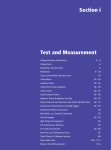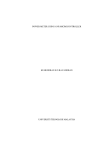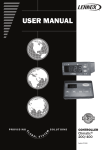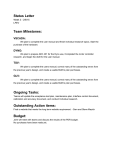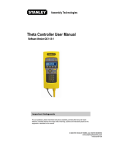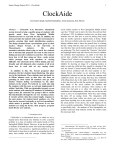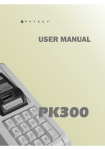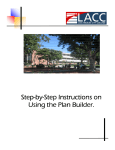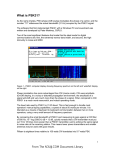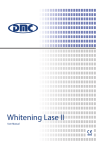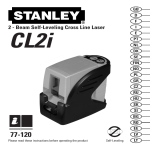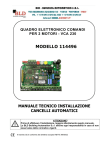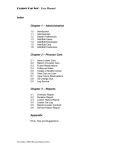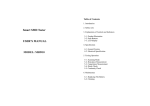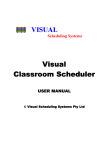Download chap. 2 installation
Transcript
INSTALLATION OPERATING & MAINTENANCE MANUAL Compact Pro Thank you for purchasing a Lennox Air Conditioning unit. You have bought one of the best air conditioners available today. Follow the instructions given in this booklet to obtain the very best performance from your air conditioner and to enjoy a fresh, comfortable Summer in complete well-being. INDEX Chap. 1 GENERAL INFORMATION 1.1 1.2 1.3 1.4 General information Symbols 1.2.1 Editorial pictograms 1.2.2 Safety pictograms Technical data 1.3.1 Overall dimensions 1.3.2 Technical features 1.3.3 Technical notes 1.3.4 Proper use List of accessories supplied 1.4.1 Storage 1.4.2 Receipt and unpacking page 3 page 4 page 4 page 4 page 5 page 5 page 5 page 5 page 5 page 6 page 6 page 6 Chap. 2 INSTALLATION 2.1 2.2 2.3 2.4 2.5 2.6 2.7 2.8 Instructions for installation Selection of position of the unit 2.2.1 Choice of best position for installing the air conditioner 2.2.2 Dimensions and features of site where air conditioner is installed Installation of the unit 2.3.1 Drilling the wall 2.3.2 Provision for draining condensate for machines with heat pump 2.3.3 Installation of air pipes and external gratings 2.3.4 Power supply connection 2.3.5 Fitting the unit on bracket Preparation for assembly/installation at high level 2.4.1 Introduction 2.4.2 Removal of front casing 2.4.3 Preparation of unit Working tests and identification of possible malfunction 2.5.1 Evacuation of condensation water in case of emergency Periodical maintenance Installation of Fresh Air Kit Installation of Wall Mounted Controller page 7 page 7 page 7 page 7 page 7 page 8 page 10 page 10 page 11 page 12 page 12 page 12 page 12 page 13 page 13 page 15 page 15 page 16 page 17 Chap. 3 USE AND MAINTENANCE (for the user) 3.1 3.2 3.3 3.4 3.5 3.6 3.7 3.8 3.9 Important Recommendations Names of parts 3.2.1 List of Units 3.2.2 Description of signal console Control of Air Conditioner using the remote control unit 3.3.1 Remote control 3.3.2 Insertion of batteries Remote control 3.4.1 Description of the remote control 3.4.2 Switching on and control of operation 3.4.3 Switching the unit on and off (button T1) 3.4.4 Automatic Operation (button T2) 3.4.5 Cooling function 3.4.6 Dehumidifier only 3.4.7 Fan only 3.4.8 Heating function (only models with heat pump) 3.4.9 Control of air flow direction 3.4.10 Control of fan speed 3.4.11 External air intake 3.4.12 Night operation 3.4.13 Setting programs for operation 3.4.14 Setting of correct time 3.4.15 Setting of time schedules for 1st and 2nd Operating Program (PROGR. 1 and PROGR. 2) 3.4.16 Starting and stopping operating programs 3.4.17 Resetting all functions of remote control 3.4.18 Control of Air Conditioner if remote control is not available Maintenance 3.5.1 Cleaning air filter Troubleshooting 3.6.1 Functional aspects that should not be mistaken for malfunctions Recommendations for energy savings Troubleshooting Spare Parts page 26 page 26 page 26 page 26 page 27 page 27 page 27 page 27 page 27 page 28 page 28 page 28 page 28 page 29 page 29 page 29 page 29 page 30 page 30 page 31 page 31 page 31 page 32 page 32 page 33 page 33 page 33 page 33 page 34 page 34 page 34 page 35 page 36 CHAP. 1 GENERAL INFORMATION CHAP. 1.1 GENERAL INFORMATION We wish to thank you, first of all, for purchasing an air-conditioner produced by our company. We are sure you will be happy with it because it represents the state of the art in the technology of home air conditioning. This manual serves to provide you with the instructions and explanations you need to make the best possible use of your airconditioner. We suggest that you read it carefully before starting to use the appliance. By following the instructions and suggestions provided in the manual, your air-conditioner will give you years of smooth operation and comfort at the lowest cost in terms of power consumption. ATTENTION The manual is divided into 3 sections or chapters: CHAP. 1 GENERAL INFORMATION Contains information for the specialized installer and end user. The information, technical data and important warnings must be known before installing and using the air-conditioner. CHAP. 2 INSTALLATION Contains information exclusively intended for the specialized installer. The information contained in this chapter is necessary for installation of the air conditioner. If the air-conditioner is installed by personnel lacking the necessary qualifications and specialization this invalidates the warranty. CHAP. 3 USE AND MAINTENANCE (by user) Contains all information and instructions for proper use and programming of the air-conditioner, as well as instructions for simple maintenance. This document is restricted in use to the terms of the law and may not be copied or transferred to third parties without the express authorization by manufacturing company. Our machines are subject to change and some parts may appear different from the ones shown here, without this affecting the text of the manual in any way. Read this manual carefully before performing any operation (installation, maintenance, use) and follow the instructions contained in each chapter. THE MANUFACTURER IS NOT RESPONSIBLE FOR DAMAGES TO PERSONS OR PROPERTY CAUSED BY FAILURE TO FOLLOW THE INSTRUCTIONS IN THIS MANUAL. The manufacturer reserves the right to make any changes it deems advisable to its models, although the essential features described in this manual remain the same. The installation and maintenance of air-conditioners like this one may be hazardous as they contain a cooling gas under pressure as well as powered parts. Therefore, the installation, first startup and subsequent maintenance should be carried out exclusively by authorized, qualified personnel. Routine maintenance of the filters and general external cleaning can be done by the user as these operations are not difficult or dangerous. During installation and maintenance, respect the precautions indicated in the manual, and on the labels applied inside the units, as well as all the precautions suggested by good sense and by the safety regulations in effect in your country. Always wear gloves and protective goggles when performing any operations on the refrigerating side of the units. Air conditioners must not be installed in places containing inflammable gasses, explosive gasses, or in very humid environments (laundries, greenhouses etc) or in places where there are machines that generate very great heat. In case of replacement of parts, use only original manufacturer parts. IMPORTANT! To prevent any risk of electrocution, always disconnect the main circuit breaker before making electric connections or performing any maintenance on the units. The following instructions must be made known to all personnel involved in the machine’s transport and installation. CHAP 1.2 SYMBOLS The pictograms in the next chapter provide the necessary information for correct, safe use of the machine in a rapid, unmistakable way. Service - Refers to situations in which you should inform the SERVICE department in the company: CUSTOMER TECHNICAL SERVICE. Index - Paragraphs marked with this symbol contain very important information and recommendations, particularly as regards safety. Failure to comply with them may result in: - danger of injury to the operators - loss of the warranty - refusal of liability by the manufacturer. Raised hand - Refers to actions that absolutely must not be performed. Danger of high voltage - Signals to the personnel that the operation described could cause electrocution if not performed according to the safety rules. Generic danger - Signals to the personnel that the operation described could cause physical injury if not performed according to the safety rules. Danger due to heat - Signals to the personnel that the operation described could cause burns if not performed according to the safety rules. CHAP. 1.3 TECHNICAL DATA (*) Maximum test conditions at high load 1.3.3 Technical notes 1.3.4 Proper use The powers indicated refer to the following conditions (ISO reference standards):: in cooling and dehumidifying mode: Air entering the inside unit at 27°C b.s. and 19°C b.u. with air entering the outside cooling and unit at 35°C b.s. in heating mode: Air entering the inside unit at 21°C b.s. and 19°C b.u. with air entering the outside unit at 7°C b.s. and 6°C b.u. The air-conditioner should be used for the exclusive purpose of producing hot or cool air (on demand) for the sole purpose of obtaining a comfortable temperature in the room. Improper use of the machine (outside and inside units) causing damage to persons, property or animals relieve producer of any liability. CHAP 1.4 LIST OF ACCESSORIES SUPPLIED The unit and all necessary ancillary items that make up the air conditioner are all packed in the one carton. Packaging may be transported per single units, by hand by two authorized persons, or loaded on a trolley, even stacking up to a maximum of three packs. The supply includes the parts listed in the table below. Before beginning to assemble the unit, make sure all the parts are within easy reach. A - Wall fastening bracket x 1 B - External air intake/outlet grids (x 2) complete with chains C - 2 tubes to insert into holes in the wall, 50 cm long D - Pipe fastening inner flange x 2 E - Kit of screws and anchor bolts F - Manual of instructions for use, maintenance, and warranty. G - Paper template to make holes 1.4.1 Storage Store the cartons in a closed environment protected against atmospheric agents and raised off the floor by planks or a pallet. DO NOT TURN THE CARTON UPSIDE DOWN 1.4.2 Receipt and unpacking The packing is made of suitable material and is done by expert personnel. The units are delivered complete and in perfect condition, however we suggest that you perform the following controls of the quality of the shipping service: - on receipt of the cartons check them for any damage and, if any is found, accept the goods with reservation, and keep photographic evidence of any damage found. - unpack and check the contents against the packing list. - make sure none of the parts have been damaged during shipment; in case of damage you must report it to the shipping company within 3 days of receipt, by registered letter with return receipt, presenting photographic documentation. Copy of any correspondence should also be sent by fax to Compact Solutions (08452 262730). No notice of damage will be accepted after 3 days from delivery. Important note: Keep the packing at least through the warranty period, in case you need to ship the air-conditioner to the service centre for repair. Dispose of the packing materials in compliance with the rules in effect for waste disposal. CHAP. 2 INSTALLATION CHAP. 2.1 INSTRUCTIONS FOR INSTALLATION To obtain the best results and optimum performance, follow the instructions for correct installation provided in this manual. Failure to follow the instructions and apply the rules indicated may cause malfunction of the appliance and relieves the manufacturer of any form of guarantee and liability for damages to persons, animals or property. The electrical system must comply with the regulations and rating data in the technical sheet, with good grounding. CHAP. 2.2 SELECTION OF POSITION OF THE UNIT The position for installation of the inside unit, to obtain the best performance and prevent breakdowns or hazards, must have the following requisites: - The bottom of the low level unit must be at least 300mm off the floor whilst the high level unit must be at least 2 meters off the floor and no more than 3 (fig. 1) - The wall on which the inside unit is installed must be sturdy and able to withstand its weight. - There should be no obstacles to the free circulation of air on the intake side and on the air outlet side especially, there should be no obstacles closer than 2 m (this could cause turbulence that would interfere with correct operation of the unit). - It must be possible to leave room around the unit for any maintenance operations that may be necessary. The air conditioner must be installed on a wall that 2.2.1 communicates with the outside. Choice of best position for installing the air conditioner Caution: After determining the best place for installation as described above, check to make sure that the wall can be drilled in that point without interfering with other structures or installations (beams, piers, pipes, wires, etc.). Check again to make sure there are no obstacles to air circulation through the holes to be drilled due to plants and their leaves, slats or paneling, blinds, gratings or grids too dense, etc.). 2.2.2 Dimensions and features of site where air conditioner is installed Before installing the air conditioner, it is essential to make an accurate calculation of the heat load in summer (and cold load in winter for models with heating pump) at the site of installation. The more accurate this calculation is made the better the air conditioner will be able to do its job. To make these calculations, refer directly to the regulations in effect (UNI ref. Law 10/91) or to the tables, both printed and computerized, based on those regulations. For particularly significant applications, we recommend contacting expert heating engineers. As far as possible, in any case, it is important to try and reduce major thermal loads by the following means: Large glass panes exposed to sunlight should be provided with curtains on the inside or shades on the outside (Venetian blinds, verandas, refracting films, etc.) The airconditioned room should be closed as much of the time as possible. Halogen spotlights or other electrical equipment with high power consumption should not be used in the room (toasters, steam irons, hot plates for cooking, etc.). - It should not be installed in a position where the air flow can strike the people underneath directly (fig. 2). - It should not be directly over another appliance (television set, radio, refrigerator, etc.), or over a source of heat (fig. 3). - There should be no obstacles for reception of signals emitted by the remote control (fig. 4). CHAP. 2.3 2.3.1 INSTALLATION OF THE UNIT This operation should be carried out using the proper tools Drilling the wall to facilitate your work and prevent excess damage or disturbance to your client. The best tools for drilling large holes in walls are special drills called core borers with very high twisting torque and adjustable rotation speed depending on the diameter of the hole to be drilled. To prevent the creation of large amounts of dust and rubble due to drilling, the core borer can be fitted with a vacuum system applied by means of suction cups to the drilling zone. Compact Solutions would be able to assist you in locating these devices. To drill the holes, proceed as follows: Fasten the drilling template to the wall leaving the necessary space from the ceiling, floor and side walls as shown on the template. Use adhesive tape to fasten it in place. Use a small drill or punch to mark, with extreme care, the exact centre of each of the holes to be drilled. Using a core boring head measuring at least 158 mm to drill the two holes for entry and exit of the air. Note: The holes should have a slight outward inclination to prevent any backflow of water from the pipes (see fig.1). Most of the removed material is expelled outwards, therefore make sure that it does not hit any person or object when it falls out. In order to avoid as much as possible outer plaster breaking, it is necessary to proceed carefully with the last part of hole execution, decreasing pressure on core borers. Fig 5 Next, drill the holes for anchoring the fastening brackets to the wall using as a first option the 4 holes on the ends of the bracket as shown on the drilling template (see fig. 6). If the wall is not very solid, it is advisable to use some extra anchor bolts. As you can see, the bracket can be fastened in a number of different ways and positions. The air conditioner is heavier on the left-hand side, so it is best to make sure of a solid anchorage on that side. The anchor bolts provided require holes with a diameter of 10 mm. In any case, the wall should be inspected carefully to determine the best possible anchorage and type of bolts suitable for particular situations. Warning: The manufacturer is not liable in case of underestimation of the structural consistency of the anchorage made at the time of installation. We therefore recommend that you perform this operation with the maximum care as, if not done properly, it can cause serious damage to persons and property. When installing models equipped with heating pump, if no drainage well for condensate has been provided built into the wall (see paragraph 2.3.2), it will be necessary, to allow for drainage of the condensate, to drill a hole through the wall measuring 16 mm in diameter in the position shown on the template (see fig.6). 2.3.2 Provision for draining condensate for machines with heat pump. When the machine is heating, it produces condensate that has to be eliminated through a specific drain line, otherwise the machine will not work. Drainage occurs by gravity. For this reason, it is essential for the drain line to have a minimum inclination of at least 3% throughout its length. The pipe can be rigid or not, with a minimum internal diameter of 16 mm. If the line drains into a sewer system, it should be provided with a trap ahead of the main outlet. The trap should be at least 300 mm lower than the inlet opening on the air conditioner (fig. 7). If the drainpipe drains into a vessel (tank or other container), this container should not be sealed and the drainpipe should not remain immersed in the water (see fig. 8). The correct position for the pipe inlet on the machine is shown on the template for drilling and positioning the machine (see also fig. 6). The air conditioner is equipped with a pipe with an external diameter of 14 mm for drainage of condensate. This pipe protrudes from the machine for a length of about 400 mm. The pipe should be fitted inside the one provided by you for a distance of at least 200 mm, without any sharp bends that could obstruct it. When draining toward the outside, the pipe can be inserted through the wall (always making sure to give it a suitable inclination) (see fig. 5). Caution: make sure, in this case, that the water expelled outward does not damage or disturb persons or property. During the winter this type of drainage may cause sheets of ice to form. 2.3.3 Installation of air pipes and external gratings After drilling the holes, the plastic pipes supplied with the air conditioner have to be fitted through them. The pipe with insulation on the inside has to be fitted in the right hand hole with the insulated part toward the inside as indicated on the label applied to it. The length of the pipes should be 55 mm less than that of the wall. To cut the pipe, a normal handsaw can be used. After cutting the pipes, fit the ends into the two internal anchoring flanges (fig. 10). The tube diameter is 152mm and should fit comfortably into the hole formed by the 158mm diameter core drill. When introducing the tubes they may need to be forced slightly using, in the most difficult cases a normal rubber hammer (fig. 10/1). Having the hole internal diameter extremely similar to the tube external diameter avoids dangerous slacks which may generate humidity infiltrations or air noises. Should the insertion prove to be too difficult, we suggest you drill using the core bit inside the hole so as to widen the internal diameter slightly. If there is excessive play and air gap around the tubes then we recommend a sealant be used to ensure a tighter fit. Next, fit the pipes into the holes in the wall and fasten the flanges with 4 anchor bolts with diameter 6, taking care to keep the two fastening holes in a horizontal position. Fig. 9 Fig 10/11 To position the external grids, proceed as follows: - Fit the small eyelet of the spring, with the long stem, on the cap pin (on both components) (fig. 10/2). - Fit the two caps (with spring), from the front part of the external grid, on the two housings, pulling until a click is heard (fig. 10/3) and attach the two chains to the large eyelet of the spring. - Using one hand, grip the two chains connected to the grid. - Bend the external grids back, gripping these with your free hand where the bend is and introducing your fingers inside the single fins (fig. 10/4). Introduce your arm into the pipe until the grid protrudes completely outwards. - Allow the grid to reopen, being careful to keep your fingers inside the fins. - Turn the grid until the fins are fully horizontal and tilted towards the outside. - Pull the chain, tensioning the spring, and fasten the ring of the chain onto the pin of the inner washer (fig. 11). - Using a pair of nippers, cut the excess chain links (fig. 12). Warning: If the external grating is accessible, to prevent the hazards resulting from its possible removal (insertion of the hands into the pipes and touching moving or powered parts) it is absolutely essential to fasten it to the wall with 4 anchor bolts with a diameter of 6 mm. 2.3.4 Power supply Connection The air conditioner is equipped with a power supply cable and plug. If it is installed near an outlet, you need only plug it in. In this case, it is important to make sure the outlet to which you are plugged in is effectively grounded and connected to the mains by wiring of adequate size (minimum 1.5 sq.mm. cross section). To make an electrical connection with the shielded cable (recommended for installations high on the wall) proceed as follows: Install a shunt box in the wall in the position shown on the installation template (fig. 6), where you should provide a power cable with a cross-section (two poles plus ground wire) of 2,5 sq.mm. Warning: The external power line should be provided with an overload circuit breaker with suitable capacity for the rating of the machine. Make all connections in compliance with the laws in effect. Close the shunt box with its cover after drilling a hole in it for passage of the cable. Alternatively, you can use a cable in the wall in the position shown on the template, for making the connection. In this case, remove the casing (as described in paragraph 2.4.2) and connect the cable to the power terminal board. Caution: these operations should be performed with the machine already positioned on the bracket. Read the instructions carefully before completely the electric connection. 2.3.5 After checking again that the fastening bracket is securely Fitting the unit fastened to the wall, and that any necessary preparations on bracket for electric connection and condensate drainage have been made, you can fasten the air conditioner to its supporting bracket. Lift it up holding the sides of the bottom (see fig. 13). To facilitate the operation of fastening it to the bracket, tilt it slightly toward you. To make the electrical connection and fasten the drainpipe, place a wedge between the air conditioner and the wall (see fig. 14). After these operations have been carried out, the air conditioner can be pushed firmly against the wall so that the bottom hook catches. When you have finished, inspect carefully to make sure there are no fissures at the back of the air conditioner (the insulating gasket must fit firmly against the wall) particularly in the zone where air enters and leaves the machine. WARNING- Please check the weight of the unit as it may require 2 people to lift it into position, especially at high level. CHAP. 2.4 PREPARATION FOR ASSEMBLY/INSTALLATION WALL TOP PART AT HIGH LEVEL 2.4.1 The air conditioner is assembled in the factory ready to Introduction be installed low on the wall. The air outlet, in this case, is at the top of the air conditioner with the recycle grating and control panel. In order to prepare the product for installation on the top part of the wall, follow the instructions below. 2.4.2 Removal of front casing Note: if the air conditioner has not been installed on the wall yet, place it on its back. To not apply heavy pressure to the bottom of the device as this could dent or scratch the casing. Use a small blade screwdriver to remove the horizontal strips on the casing, applying gentle leverage in the slits along the sides. (see fig. 15). Take care not to scratch the strips or casing with the screwdriver point. Unscrew the 8 self-threading screws that fasten the casing to the air conditioner. Lift the casing off carefully, pulling it toward you by about 50 cm (see fig. 16). Disconnect the fastener on the right that fastens the wires to the airflow deviation baffle adjustment motor (see fig. 17). Now you can remove the casing completely. 2.4.3 Preparation of unit Unscrew the bracket supporting the small circuit board with display LED’s and reinstall it on the bottom opposite, where you will find two holes on the base (see fig. 18-19). Make sure the connection plate is securely fastened on the inside of the air conditioner, and apply some insulating tape if necessary. Remove the styrofoam enclosure on the lower right-hand side under the air recycle fan and fit it against the opening above the fan (see fig. 20-21). Remove the air outlet grating by removing the fastening screws. Remove the control panel (see fig. 22). When performing this operation place the casing on a secure surface so as not to scratch or dent it. Remove the plastic plate with the logo and transparent screen for display of the LED’s from the control panel by pressing on the hooks at the rear. Turn it over (rotate by 180°) and reinstall it on the panel. Reassemble the parts in the opposite position from the original installation, reversing the air outlet grating with the control panel grating. Turn the casing over so that the air outlet grating is on the lower right-hand side of the device. Connect the plug on the step-step motor of the grating. Fit the casing back on the air conditioner carefully, taking care to hold the wires for the stepstep motor to one side so that they do not interfere with the inner part of the air outlet grating. Check that all the coupling references of the casing with the rear frame are fully inserted so that the casing is fitted smoothly and evenly all around. Fasten the casing with its eight screws and replace the strips in their slots. After completing installation, the electronic parts of the air conditioner have to be configured so as to take into account the stratification of heat in the room. This procedure is outlined in paragraph 2.5 (Operating tests and diagnosis of possible malfunctions). CHAP. 2.5 WORKING TESTS AND IDENTIFICATION OF POSSIBLE MALFUNCTIONS The program introduced in the microprocessor of this device makes it possible to run a brief self-test to ensure that the machine functions normally by starting each of its internal components. To run the self-test, proceed as follows: - Power the air conditioner and make sure it is on stand-by. – U Use a sharp object to press the micro-key located under the hole on the left of the control panel for at least 10 sec. - At the beginning and end of the self-test procedure the status of configuration of the machine will be displayed for a few seconds as follows: red LED (filter): green LED (compr.): orange LED (timer): green LED (power): - off = UNICO on = UNICO HP (with heat pump) off = with correction of room temperature on = without correction of room temperature off = without correction of room temperature on = with correction of room temperature off = stand-by in case of blackout on = restart in case of black-out green orange green red Check after a few seconds to see whether the equipment heats normally (if equipped with heat pump function) for about 2 minutes and then, after a few seconds, that it cools for another 2 minutes. Before concluding the self-test, the electronic part tests the temperature probes to make sure they are operating normally. If any of these should not be working, the corresponding signal led remains lit for 20 sec. (see table on next page). Should there be a jam in the air-conditioning system with alarm signals according to the table here following, please be ready to refer to the Service Centre which LED’s are blinking in order to simplify their intervention. Starting from the left: CODE ALARM 1-FS 2-HTI 3-HTE 4-LT 5 6-CF/RL 7-OF 8-CKS 9 10-TSF 11-TSF 12-TSF 13-TSF 14-TSF 15-TSF DESCRIPTION POWER dirty filter internal battery overheat external battery overheat internal battery low temp. pump working continuously batt. temp. not reached water level eeprom parameters not valid short on room sensor room sensor disconnected short on evaporator sensor evap. sensor disconnected short on condenser sensor condenser sensor The end of the self-test will be signalled by all the LEDs lighting up at once and blinking ten times, as well as by an acoustic signal. At this time, you can adjust the temperature reading on the room temperature sensor. This correction is important if the air conditioner is installed high on the wall in a room where the warm air tends to stratify upward (as in rooms with high ceilings or other sources of heat besides the air conditioner). The sensor will read a temperature 3°C lower than the effective one, in this case, to compensate for the difference between the lower inhabited part of the room and the temperature at the height of the sensor. To enter or remove this correction proceed as follows: 1 Check the status of the machine as described previously, and if no correction has been made, press the button on the console while the acoustic signal is on at the end of the self-test. 2 To remove the correction, press the button while the acoustic signal is on at the end of the self-test. green LED orange LED green LED TIMER COMPR. FILTER red LED O O O O O O O O O O O O O O O O O O O O O O O O O O O O O O O O The machine is set in the factory without correction of the temperature. In addition to the self-test (that can be made under any conditions of room temperature) we recommend that you also test the product in the various operating modes accessible to the user (see the user manual). One important test you should make concerns regular evacuation of condensation water on the models with heat pump. To check this, keep the machine running for at least 4-5 hours in the heating mode. If the water does not drain, there should be an “overflow” alarm. 2.5.1 Evacuation of Condensation water in case of emergency CHAP. 2.6 If there should be a malfunction in the condensation water drain system, the air conditioner stops working and signals, with flashing orange, green and red lights (the second and third LEDs from the left), the alarm status. To enable the air conditioner to work temporarily until the service personnel arrives, you can drain the water out by following these simple instructions: - Grasp the rubber cap on the bottom centre of the air conditioner behind the edge of the frame facing the wall between your thumb and forefinger. - Pull the rubber tube closed by the cap out by a few centimetres. - Remove the cap after placing a bucket or other container underneath it (at least five litter capacity) to collect the water (see fig. 23). - After eliminating the malfunction the service personnel will take care of closing the evacuation tube. PERIODICAL MAINTENANCE Air conditioners of this type do not require any particular routine maintenance except:: - Cleaning or washing the room air filter when the red led lights up (see user manual). - Cleaning of “external air” battery, to be done as needed, depending on the amount of dirt in the external air, once or twice a year. To do this, you must, of course, open the air conditioner by removing its casing and the noise insulation on the inside. - Cleaning can be done using a vacuum cleaner or soft brush, taking particular care not to damage the aluminium heat exchanger baffles. It may be necessary to use water and detergents to remove heavily encrusted dirt. Note: after cleaning the battery replace the noise insulation carefully matching the edges and gaskets with their reference markings. Before you leave the site of installation you should gather up all packing material and use a damp cloth to remove any traces of dust that may have deposited on the machine during assembly (fig. 24). These operations, though certainly not essential, have a beneficial effect as they enhance the professional image of the installer in the eyes of the client. To prevent unnecessary calls by the user, before you leave the site of installation it is also a good idea to: - Explain the contents of the Instruction Manual to the user. - Show him how to clean the filter. - Explain when and how he should contact the Service Department Fig. 24 CHAP 2.7 INSTRUCTIONS TO INSTALL THE FRESH AIR KIT KR100 The fresh air kit allows the outside air to enter into the room where the air conditioner is located. This device guarantees that about 90 m3/h are brought into the room, resulting in a very good change of air. Follow carefully these instructions and you will be able to install perfectly the appliance. NOTICE • • • • • The kit has to be mounted to the wall before the air conditioner It have to be installed on an outside wall, preferably not on the walls looking onto a road or places where there are polluting substances The minimum height from the ground must be at least 6 metres for walls looking onto high traffic-congested roads and 3 metres in all the other cases. Check that nothing could obstruct the airflow at the device inlet (trees with leafs, curtains, etc..) To improve the air downflow from the room it is recommended to install a plenum lock-gate with approx. dimensions 150x150 mm. INSTALLATION After having determined the position of the indoor unit fixing bracket, trace the centre of the hole following the instructions of picture 1. • • - • • • • Drill the wall using a suitable drill equipped with core bit with a diameter of at least 132 mm. The hole has to be perfectly horizontal, or at the most having a slight inclination toward outside. Put the 130-mm. pipe into the hole, after you cut it according to the wall thickness. ATTENTION: the pipe supplied with the kit is long max. 500 mm; for thicker walls you have to ask for a longer pipe to the Service Centres. Seal the pipe at both ends using some silicone or stopper Apply the outdoor grid, equipped with grate against insects, by means of at least 2 dowels diam. 6 (supplied with the kit) and putting silicone between the wall and rear part of the grid before fixing it. Put the fan/lock-gate assembly in the hole from inside the room, leaving the power cable in the lower part (picture 3). Take the inside protection grid away, fix the device to the wall with at least two dowels diam. 6 and then reassemble the grid. Now install the indoor unit following the user manual’s instructions; before closing the front panel, connect the connection cable to the kit as follows: o Let the cable pass through the special hole that is placed on the rear casing as shown in picture 2 and position the fairlead that is already threaded on the connecting cable Calculate the length of the pipe bringing it near the male connector placed on the electronic board and put the terminals in the special female connector supplied with the kit. Connect the connector to the electronic board. Close the front panel and test the working of the air conditioner. 2.8 INSTALLATION OF WALL MOUNTED CONTROLLER Read carefully these instructions before proceeding with any operation (installation, maintenance, use) and follow everything described in the notes below. Any warranty is not valid for problems related to wrong installation, extraordinary natural events, wrong calculation or misuse. THE MANUFACTURER DOES NOT ACCEPT RESPONSIBILITY FOR DAMAGES CAUSED BY NOT OBSERVING THE INSTRUCTIONS IN THIS MANUAL. The manufacturer has the right of modifying the unit at any time whilst maintaining the main features described in this manual. During installation or maintenance it is necessary to follow all procedures described in these notes and all labels stuck inside the unit and all precautions suggested by common sense and by local laws. In case of substitution of components, use only the manufacturers recommended parts . IMPORTANT! In order to avoid electric shock it’s necessary to disconnect the unit from the main power line before doing any electric connection or any maintenance operation. INSTALLATION Only authorized and qualified personnel can make the installation. It is necessary to strictly follow the instruction of this manual. Not following the instructions may cause malfunction of the device and warranty won’t be valid anymore. B1000 can work in stand alone or in a network, by changing the set of switches. Positioning of B1000. The card must be place next to the unit, since the communication cable is 80 cm long and cannot be extended in order not to lose data. Leave enough space around the card to make maintenance. Installation Chosen the place of installation, make the hole in the wall using the drilling template (A), open the box by taking the screw on the right side out (B). To fix the box to the wall use the screws that are given in the pack (C). Attention Be very careful in order not to damage the card and its components during the fixing procedure. Follow strictly the table when arranging the electrical connection. Fixing Dimensions Installation of wall control Using the drilling template, fix the wall control to the wall at 1,5m from the floor. The control can be installed in normal electrical box in the wall. To open the control box push the trigger on the left side and lift rotating towards the other side. Positioning If you put the control farer than 2m from the conditioner you have to take a loner wire. In this case use a wire 5x0,34mm Attention Be very careful in order not to damage the card and its components during the fixing procedure. Follow strictly the table when arranging the electrical connection. Electrical connection Follow the table “Connections” when connect all wires. CONNECTIONS Connector K1 Branch input K2 CAN BUS mains K3 Serial for the air conditioner K4 Contact occupied room K5 Keyboard connection Function 1 2 3 Neutral Phase GND 1 2 3 4 CAN-L CAN-H GND Screening 1 2 3 TX GND RX 1 3 Contact room Common 1 2 3 4 5 Red White Brown Blue Black Cable Cable 3x0,75 230v 50Hz (given) Screened cable 3x0,34 Given Not extendible Cable 2x0,75 Branch input Clock Out data In data Common (GND) Given cable 5x0,34 L=200 mm Verify: - Use the electrical power 230V / 50 Hz K1 - Connect the cable connection to the keyboard K5 - Connect the eventual room contact K4 - Connect the supplied serial connector to the air conditioner - Connect the mains CAN-BUS K2 as specified in the instructions (if you use the mains connection). DIP- SWITCH CONFIGURATION On the board there are 12 microswitches (dip-switch) that are subdivided in two groups of 4 (S1) and 8 (S2) selectors. The selectors marked with the initials A0 A8 are put in charge of the addressing of the board itself , that is they identify the board on the CAN bus ; the ones marked with the initials CFG1 CFG3 select some board’s functions. The configuration of these selectors is seen on the ignition of the board; therefore it is necessary to switch off and to switch on when you modify the disposition. Find below the description of the function of each selector: SELECTOR A0-A8 CFG1 FUNCTION 1 Address board 2 Brilliance Led 0 SELECTOR POSITION 1 X X Normal Reduced 3 4 CFG2 Type of contact occupied room N.A.(norm. Open) N.C.(norm. Closed) CFG3 Board model Stand-alone In mails 1 The address of the board on CAN bus has to be unique and unequivocal; the coding is expressed on the basis 2. 2 The function of this selector is active only for the configurated board that are not in mails; the brilliance of the led for the boards in mails has to be determined through a specific command from the reception. 3 Closed occupied room 4 Closed free room EXAMPLES Control board n° 321 (101000001) in mains with contact room N.C. (norm closed) Control board nº 123 (001111011) stand-alone with reduced brilliance of the led and contact N.A. (norm. open). Stand-alone configuration. 1 SIMPLIFIED WALL CONTROL 1 ON/OFF button A Automatic pilot light: It lights up when the air conditioner works in compliance with the parameters set up by the reception. B ON pilot light: It lights up when the air conditioner is working. 2 TEMPERATURE SETTING Button Pressing this button, you can change periodically the temperature set by the reception of + 2°C, - 2°C and t. set. C Temp. – pilot light; it lights up when it is fixed a temperature 2°C lower than the set one. D Temp. + pilot light; it lights up when it is fixed a temperature 2°C higher than the set one. When the pilot lights are off the fixed temperature is the set one. 3 FAN SPEED CONTROL Button By pushing the button it is possible to change the fan speed. E Min. speed pilot light F Medium speed pilot light G Max. speed pilot light E+G Automatic speed pilot light When the pilot lights are off, it means that the set speed is the default one set by the reception. PROGRAMMING (STAND-ALONE FUNCTIONING) LENNOX For the stand-alone working you have to select the functioning mode, the ventilation speed and the set temperature with the remote control. Once the machine is started through the remote control in compliance with the above data, you have to press the button placed on the power board (see picture) to store on the Eprom the chosen data. Now the user, using the simplified wall control, can control the air conditioner in accordance to what specified in the previous page. CHAP. 3 USE AND MAINTENANCE (for the user) The air conditioner must not be installed in rooms where explosive gasses develop or where there are conditions of heat and humidity beyond the maximum limits indicated in the installation manual. Clean the air filter periodically, as described in the specific paragraph. 3.2 3.2.1 List of Units 3.2.2 Description of signal console NAMES OF PARTS 1) 2) 3) 4) 5) 6) 7) Air outlet grille. Cursors for lateral adjustment of airflow. Motor-operated air baffles for upward airflow Alarm display console. Air intake grating. Grips for removal of air filter. Rubber hose with cap on end for evacuation of condensation water in case of emergency. 8) Power cable 1) Transparent zone for receipt of remote control signal. 2) Green led indicating machine is running (When the machine is on stand-by this light is off). 3) Orange led indicates on/off programming is in use. 4) Green led indicates cooling compressor is on. 5) Red led indicates air filter clogged. 6) Service microkey (RESET) Fig. 25 Fig. 26 3.3 CONTROL OF AIR CONDITIONER USING THE REMOTE CONTROL UNIT 3.3.1 The remote control supplied with the air conditioner is Remote control designed to be extremely sturdy and to ensure excellent performance in use, but it should nevertheless be handled with some care. For example, do not: - leave it out in the rain, spill water on its keyboard or drop it into water. - subject it to impacts or drop it onto hard surfaces. - leave it exposed to direct sunlight. - place obstacles between the remote control and the air conditioner while using it. Furthermore: - if other devices operated by remote control (TV, radio, stereo systems, etc.) are located in the same room as the air conditioner, there may be interference. - electronic and fluorescent lighting may interfere with communications between the remote control and the air conditioner. - remove the batteries in case of prolonged disuse of the remote control. 3.3.2 Use only 2 dry cell batteries type LR03 with 1,5 V (supplied Insertion of with the remote control unit). Dispose of used batteries batteries only at the special collection points provided by the local authorities for this type of waste. REPLACE BOTH BATTERIES AT THE SAME TIME To insert the batteries remove the spring-latch cover on the back of the remote control. The batteries have to be inserted according to the positive and negative pole markings in the bottom of the battery compartment. Close the spring-latch cover after inserting the batteries. 3.4 REMOTE CONTROL The remote control is the interface between the user and the air conditioner. It is therefore particularly important to familiarize yourself with the parts of the remote control that relate to this interface. 3.4.1 T1 On/Off. Description of the remote Control T2 T3 T4 T5 T6 T7 D1 Well being mode (Automatic) Night well-being mode Operating mode selector. Fan speed selector. Button for setting timer and programs. Button for increasing (+) or decreasing (-) the temperature/time settings. Button to start external air intake (functions only if the air conditioner is equipped with this accessory). Movable baffle adjustment On/Off button. Reset button. Program start button. Display: shows operating status and settings as they are made. Fan speed or automatic operating mode indicator D2 D3 D4 (AUTO). Heating. Cooling. Dehumidifier only. T8 T9 T10 T11 D D5 D6 D7 D8 D9 D10 External air intake switch. Night operation switch. Automatic operation switch. First operating program switch. Second operating program switch. Temperature indicator (thermometer) or time indicator (H M). The remote control is also equipped with a cover with a cursor that can be positioned so as to permit access only to the ON/OFF, AUTOMATIC MODE and NIGHT MODE buttons. With the cover in this position the air conditioner can be used but none of the settings can be tampered with. 3.4.2 Switching on and control of operation In order to command the machine via the remote control, the main switch on the electric line (ask the technician who installed the machine about the main switch position) must be on and the mains plug of the machine must be plugged in. Once these operations have been carried out, the machine may be regulated using the remote control. To send commands to the air conditioner, point the front of the remote control toward the air conditioner control panel. The device emits a beep when it receives a command. The maximum distance for transmission of commands is about 8 meters. T1 Fig. 28 Switching the unit on and off 3.4.3 Switching the unit on and off (button T1) 3.4.4 Well being mode (Automatic) (button T2) 3.4.5 Cooling function This button turns the machine on or off. The machine’s control system has a memory, therefore any setting will not be lost when it is turned off. This button serves to switch the air conditioner on or off for brief periods of time. In case of prolonged stop of the machine, it must be deactivated turning the main switch off or unplugging the machine from the mains. By means of this button the machine is automatically regulated in order to create an optimal comfort temperature in the air-conditioned room. The machine’s temperature is automatically regulated according to the room’s temperature. The fan speed is also automatically regulated according to the set temperature (except in dehumidification use). When used in this mode, the air conditioner dehumidifies and cools the room. Button T4 is used to select the operating mode. Press until the snowflake symbol appears on the display. First set the desired temperature and fan speed (see the relative paragraphs). After three minutes (maximum time), the compressor should start up and the air conditioner should start cooling the room. When the compressor starts you will see a green LED light up on the control panel. Fig. 30 Cooling function 3.4.6 Dehumidifier only When used in this mode, the air conditioner only eliminates the humidity in the room, practically without changing the temperature. This function can be extremely useful between seasons, particularly on rainy days when the temperature is not uncomfortable but the excess humidity feels unpleasant. When used in this mode, the air conditioner ignores the temperature and fan speed settings, which are not shown on the display in this case. To operate the air conditioner in this mode, press Button T4 until the droplet symbol appears on the display with automatic ventilation. In this operating mode it is normal for the air conditioner to function intermittently. 3.4.7 When used in the mode the air conditioner does not act on the Fan Only either the temperature or the humidity in the room, but only keeps the air in circulation. This operating mode is selected by pressing button T4 until the fan symbol appears on the display. At this stage you can select the fan speed (see paragraph 3.4.10). 3.4.8 Heating function (only models with heat pump) When used in this mode the air conditioner heats the room. This function is only available on models with a heating pump (HP). To select this mode press button T4 (operating mode selection switch) until the sun symbol appears on the display. First set the desired temperature and fan speed (see the specific paragraphs). After three minutes (maximum time) the compressor should start and the air conditioner starts heating the room. When the compressor starts you will see a green LED light up on the control panel. Note: The air conditioner has to defrost its battery periodically (about once every half hour). During this operation (about 3-8 minutes) the air conditioner does not heat the room, though its internal parts remain on except for the room air fan. When the outdoor temperature is very low, there may be a slight delay (about 3 minutes) for passage from the minimum to the medium or maximum speed from when the command is sent to the machine with the remote control. 3.4.9 Control of air flow Direction Fig. 32 Fan only The airflow can be controlled in both its horizontal and vertical direction. Control of the horizontal direction cannot be carried out with the remote control and must be made manually by adjusting the position of the fins on the outlet opening. Fig. 33 Heating function (only models with heat pump) IMPORTANT: Adjustment of horizontal airflow should only be made when the movable grille is not moving. Fig. 34 Control of air flow direction To adjust vertical airflow you can operate in two ways: - continuous oscillation of airflow, obtained by pressing button T9 which starts and stops the movable grille. This enables the fins on the grille to turn completely around. - stop the movable grille in the desired position by pressing button T9 again while the fins are in motion. Pressing button T9 will start automatic turning of the baffle. IMPORTANT: The baffle must not be turned by hand. 3.4.10 Control of fan speed Fan speed is controlled by button T5. Pressing this button gives the following sequence: once=Low, twice=Medium, three times=High, four times=Automatic. The higher the speed setting, the greater the output of the air conditioner but also the louder its operation. If you select Automatic mode, the microprocessor in the air conditioner adjusts the speed automatically, keeping it as high as needed to reach the temperature setting with respect to the effective room temperature. As the room temperature nears the setting, fan speed is reduced automatically. When the unit is operating in dehumidification mode, fan speed adjustment is not possible as it can only function at low speed. Fig. 35 Control of fan speed 3.4.11 External air intake This function is available only on devices equipped with the optional external air intake, that is an exclusive feature for this type of air conditioner. Press button T8 once to start the microfan on the external air intake and open the shutter to refresh the air in the room. Press button T8 again to close the shutter. It should be borne in mind that opening the external air intake reduces the cooling effect of the air conditioner. This is also true of the heating effect for machines equipped with a heat pump. For this reason, if you want to maintain a constant flow of external air with the air conditioner in operation, you should first make sure your unit is powerful enough to operate this way. If not, you should close the external air intake when the temperature outside is extreme. Fig. 36 External air intake 3.4.12 Use button T3 to select Night comfort Mode, which includes Night Comfort the following functions: mode - Gradual increase of the temperature set for coding. - Gradual reduction of the temperature set for heating (only HP models). - Reduction of noise level. - Lower energy consumption at night. To select Night comfort mode press button T3 after selecting the operating mode using button T4 and setting the temperature using button T7. Ideally, you should start night well-being mode operation just before you fall asleep. In cooling mode, the set temperature is held for one hour after starting Night comfort mode operation. For the next hour, the setting is allowed to increase gradually up to 2°C over the original setting, while the fan speed setting is low. After the second hour, the temperature and fan speed settings are not changed. In heating mode, the set temperature is held for one hour after starting Night well-being mode operation. For the next hour the setting is lowered gradually to 4°C below the original while the fan speed setting is low. After the second hour, the temperature and fan speed settings are not changed. Night comfort mode operation is not available for dehumidifying only. Night comfort mode operation can be halted at any time (ideally when you wake up in the morning) by pressing button T3 again. At this stage the temperature and fan speed settings made prior to starting Night comfort mode operation go back into effect. 3.4.13 Setting programs for operation The air conditioner logic provides the user with a choice of two operating programs that can be set to start and stop at programmed times, for example you might want the air conditioner to start shortly before you return home so that it is cool when you get there. To use these functions it is first necessary to set the exact time on the remote control and then set the time for the programs to start. 3.4.14 Setting of correct time To set the exact time proceed as follows: a) Press button T6 Time and Program Setting, as many times as necessary to display the hour indicator (H). b) Press the toggle button T7 to increase or decrease the numerical display until it shows the exact hour. c) Press button T6 again to display the minute indicator (M). d) Press toggle button T7 to increase or decrease the numerical display until it shows the exact time in minutes. Fig. 37 Night well-being mode Fig. 38 Setting of correct time 3.4.15 Setting of time schedules for 1st and 2nd Operating Program (PROGR. 1 and PROGR. 2) To set the times for starting and stopping the two air conditioner programs, proceed as follows: a) Press button Time and Program Setting, as many times as necessary to display the PROGR. 1 ON indicator (Time to start 1st program). b) Press toggle button T7 to increase or decrease the numerical display of the time when you want program 1 to start. Every time you press one end of the toggle button the time setting increases or decreases by 30 minutes. c) Press button T6 Time and Program Setting, as many times as necessary to display the PROGR. 1 OFF indicator (Time to stop 1st program). d) Press toggle button T7 to increase or decrease the numerical display of the time when you want program 1 to stop. Every time you press one end of the toggle button the time setting increases or decreases by 30 minutes. e) Press button Time and Program Setting, as many times as necessary to display the PROGR. 2 ON indicator (Time to start 2nd program). f) Press toggle button T7 to increase or decrease the numerical display of the time when you want program 2 to start. Every time you press one end of the toggle button the time setting increases or decreases by 30 minutes. g) Press button T6 Time and Program Setting, as many times as necessary to display the PROGR. 2 OFF indicator (Time to stop 2nd program). h) Press toggle button T7 to increase or decrease the numerical display of the time when you want program 1 to stop. Every time you press one end of the toggle button the time setting increases or decreases by 30 minutes. i) To return to the normal operating mode just press button T6 as many times as necessary to cancel the program indications from the display. Fig. 39 Setting of time schedules for 1st and 2nd Operating Program (PROGR. 1 and PROGR. 2) 3.4.16 Starting and stopping operating programs After making the settings for the operating programs, they can be used or not, as needed. Either or both of the programs can be used. In particular, when you press T11 to run the programs, the following things occur: Use of Program no. 1 only Use of Program no. 2 only Use of Programs 1 and 2 Disuse of both programs. Fig. 40 Starting and stopping operating programs 3.4.17 Resetting all functions of remote control 3.4.18 Control of Air Conditioner if remote control is not available 3.5 Press button T10 to reset all the settings on the remote control. This will cancel all the settings of the timer and the remote control will use the default settings. In addition, by pressing T10 you will display all possible indications so that you can verify the proper conditions of the display. If you lose the remote control unit, or the batteries are dead or it is not working for any other reason, you can still control the air conditioner in the automatic mode using the microswitch on the console, that is the same switch that has to be used to reset the clogged filter alarm light. To do this, proceed as follows: - Make sure the red clogged filter alarm LED is not on. If it is on, clean the filters and reset the indicator light as described in paragraph 3.5.1 Cleaning of air filter. - Use a sharp object to press the microswitch located under the hole on the console. - The air conditioner will function in “AUTO” mode. To restore normal operation under the control of the remote control unit, you need only give any command with the remote control unit when it becomes available again. Fig. 41 Resetting all functions of remote control MAINTENANCE Your air conditioner has been designed to reduce operations of routine maintenance to a minimum and ensure that they can be performed easily by any user. The only operations required are the three types of cleaning illustrated below. 3.5.1 Cleaning air filter To ensure effective internal air filtration and satisfactory operation of your air conditioner, the air filter has to be cleaned periodically. The need to perform this important operation is signalled after a prolonged period of use by a red led lighting up on the control panel (see fig. 26). The filter is located on the front of the air intake grating on the back of the machine. To remove it, press on the two fastening hooks and pull the filter toward you (see fig. 42). Wash the filter by forcing a jet of water in the opposite direction from that of dust accumulation. In case of dirt that is hard to remove (such as grease or other encrusted dirt) you may have to soak the filter first in a solution of water and neutral detergent. Before replacing the filter shake it to eliminate the wash water. The last part of this operation consists of briefly pressing, with a sharp object, the microkey located on the control panel. The red led goes off and lights up again after the air conditioner has been in operation for a few days. Fig. 42 Cleaning air filter 3.6 TROUBLESHOOTING It is extremely important for the user to know when behaviour that seems like a malfunction really isn’t. Among these are some (that we will indicate) that the user can easily correct following our simple instructions, while in other cases it is necessary to get in touch with our service personnel. We also wish to remind you that any attempts to repair the equipment made by unauthorized personnel will immediately invalidate the warranty. 3.6.1 Functional aspects that should not be mistaken for Malfunctions CHAP. 3.7 The compressor does not start up again immediately after a stop (it takes about three minutes to start again). The operating logic of the device provides for a delay between stoppage of the compressor and starting up again. This is to safeguard the compressor. - When heating, on versions with the heating pump, the machine does not start emitting heat until a few minutes after the compressor starts. If the fan should go into operation at the same time as the compressor, for the first few minutes it would emit cold air into the room (and this could disturb the occupants) as the heating function needs some time to warm up. This is why the fan startup is delayed until after the compressor has started. RECOMMENDATIONS FOR ENERGY SAVINGS - Always keep the filters clean (see chapter on maintenance and cleaning). - Keep the doors and windows closed in the air conditioned rooms. - Keeps sunlight out of the room by using curtains, lowering the shades or closing the shutters. - Do not obstruct the air flow (intake and outlet) on the units; this in addition to reducing the performance of the system, will jeopardize correct operation and could cause irreparable damage. CHAP. 3.8 TROUBLESHOOTING In case of malfunctions of the air-conditioner, check the items in the table below If, after making the suggested check the problem is not solved, contact your authorized service centre. - The air conditioner does not switch on. This may be due to: - lack of power; what to do: - Make sure power is being supplied (by switching on a light in the house, for example). - Make sure the main circuit breaker is closed and the fuse is not burnt out (replace the fuse if necessary. If instead of a circuit breaker you have installed a cutoff switch, make sure it has not been tripped (reset it if necessary). If the problem persists, contact our Service Department and do not try to start the air conditioner. - The batteries in the remote control are dead. If the batteries are dead you will notice the absence of indications on the display and the failure of the air conditioner to beep when you try to send it a command. In this case, replace the batteries. - The device no longer cools satisfactorily, this could be due to: - The temperature set on the remote control being too high or too low (for models with heat pump); what to do: - check and, if necessary, correct the temperature setting on the remote control. - The air filter is clogged before the alarm indicator lights up. what to do: - check and clean if necessary.. - Something is obstructing the airflow to the inside or to the outside; what to do: - remove anything that could obstruct airflow. - There has been an increase in the heating or cooling load (for example a door or window has been left open or a device that dissipates a large amount of heat has been installed in the room); what to do: - make sure the doors and windows are closed; if a heat source has been installed in the room that raises the temperature excessively and for which the air conditioner is unable to compensate, the only solution is to install another air conditioner or replace the existing one with a more powerful model. - The air conditioner stops and the second and third led from the left on the control panel (orange, green and red lights) start flashing; If there should be a malfunction in the condensation water drain system, the air conditioner stops working and signals, with flashing orange, green and red lights (the second and third LEDs from the left), the alarm status. To enable the air conditioner to work temporarily until the service personnel arrives, you can drain the water out by following these simple instructions: - Grasp the rubber cap on the bottom centre of the air conditioner behind the edge of the frame facing the wall between your thumb and forefinger. - Pull the rubber tube closed by the cap out by a few centimetres. - Remove the cap after placing a bucket or other container underneath it (at least five litter capacity) to collect the water. - After eliminating the malfunction the service personnel will take care of closing the evacuation tube. IMPORTANT: If you are unable to classify the problem as one of those described above, you should immediately get in touch with Compact Solutions without attempting to make any repairs yourself. Chap 3.9 Spare Parts listing Code 276311A74 01M0263 03M0018GU17 03M0049GU31 05M0076 18M0130 03M0035GT05 03M0023GT05 592987A 21M0137 21M0138 271968A 276274A 276269A 277582A 276276A 276295A 03M0278GS33 03M0024NN17 275998A 275999A 05M0194 281692B72 23M0114 275971A 591908A85F 591908A85H 591908A11F 591908A11H 23M0075 03M0045GS33 13S0380 03M0012GT37 255546A70 275964A 276309A 03M0017GT05 599918A 01M0259 24M0280 256413A 598868A 598869A 02M0087BO34 01M0258 03M0083BP35 599919A1 599919A1 COMPACT PRO AND PRO PLUS Description REMOTE COTROL OUTLET AIR VOLUTE UNIT HOOD SCREW RUBBER COVER STEP MOTOR LED BASE FIXED GRILLE CONTROL BOARD LED FACIA STRIP COMPRESSOR INSULATION UNIT SIZE 21 COMPRESSOR INSULATION UNIT SIZE 24 COMPRESSOR GASKET COMPRESSOR GOLDSTAR GK080PAA UNIT SIZE 21 COMPRESSOR GOLDSTAR GK113PAB UNIT SIZE 24 KLIXON COVER KLIXON COMPR GOLD MRA 12009-12026 UNIT SIZE 21 KLIXON COMPR GOLD MRA 12130-12026 UNIT SIZE 24 FLOAT MICRO SWITCH SUPPORT MICRO SWITCH MICRO SWITCH TRIGGER DRAIN PUMP CONDENSATE DISTRIBUTOR CENTRIFUGAL FAN CAPACITOR 4mF ELECTRONIC BOARD UNIT SIZE 21 cooling only ELECTRONIC BOARD UNIT SIZE 21 heating ELECTRONIC BOARD UNIT SIZE 24 cooling only ELECTRONIC BOARD UNIT SIZE 24 heating RADIAL FAN EVAPORATOR FAN PLUG INDUCTOR 250mH 500mA INTERNAL AIR FILTER POWER CABLE CAPACITOR 25mF UNIT SIZE 21 CAPACITOR 30mF UNIT SIZE 24 SUCTION GRILLE EXTERNAL GRID CONDENSATE DISPOSAL GROUP EVAPORATOR CONDENSER 4 WAYS VALVE UNIT SIZE 21 4 WAYS VALVE UNIT SIZE 24 AIR INLET PIPE AIR OUTLET PIPE INNER FLANGES GRILLE FIXING CHAINS GRILLE RETAINING SPRINGS PRO PLUS MODEL ONLY Explosion view 1 2 3 4 5 6 7 8 9 10 10 10 10 10 10 11 11 12 12 12 12 13 14 15 16 17 17 17 17 18 19 20 21 23 24 24 25 29 31 32 33 35 35 36 37 38 40 41 Lennox UK Cornwell Business Park Salthouse Road Brackmills Northampton NN4 7EX Tel: 01604 669100 Fax: 01604 669150 [email protected] www.lennoxuk.com 07-2005










































